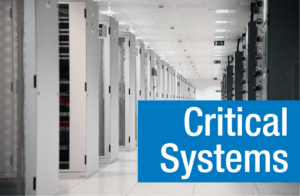
Option #1: Serve your white space off of the existing building system
- Pro’s:
- Lowest initial cost, as no new equipment is being purchased
- No equipment lead time makes for a quick installation turn around
- Con’s:
- Building cooling system is not designed to maintain consistent space temperatures and will allow fluctuations
- Requirement to operate building cooling system 24/7
- Conclusion – Cooling a server room off of the existing building system is tempting and the low first cost can be worth it in small data room applications, assuming you are willing to operate your building cooling system 24/7.
Option #2: Install dedicated DX split systems or chilled water fan coil units
- Pro’s:
- Does not require the installation of any additional infrastructure, minimizing install cost.
- Can be installed modularly based on demand
- Con’s:
- This equipment is not designed with internal controls, leading to temperature fluctuations.
- Typically less efficient and more prone to failures as the equipment is not designed for non-stop use.
- Conclusion –This system works best if you are looking to add 1-2 separate data closets with no plans of future expansion. If the data space can be consolidated, there are less expensive options that are more effective.
Option #3: Precision perimeter cooling units – Upflow and Downflow
- Pro’s:
- Flexible installation with options to balance install and energy costs (VFDs, EC fans, economizer settings, back-up coils, control sensor options)
- Typically more energy efficient than traditional units
- Precisely control your space temperature and humidity
- Downflow units with raised floor air distribution makes it easy to alter your supply air locations as your load changes
- Con’s:
- Higher initial cost of equipment
- Hot spots can occur at servers furthest from cooling units
- If needed, raised floor installation has a high initial cost.
- Require some means of moving the cooling to your equipment.
- Conclusion: Perimeter units became the installation standard for a reason. While the install cost can be high, the flexibility of equipment and install options is worth it in critical applications.
Option #4 – Precision In-Row cooling units
- Pro’s:
- Typically more energy efficient than traditional units
- Reduce bypass by delivering the cool air directly to your equipment
- Modular installation lowers day one cost and allows your HVAC to expand with your needs
- Con’s:
- Relocation of a rack requires unit reinstallation
- Requires hot aisle/cold aisle configuration to deliver optimal cooling
- While modular deployment minimizes first cost, the need for multiple installations creates a higher full build out cost.
- Conclusion: In row installation provides the same level of precision as perimeter units. The modular installation increases total cost, but if you are building out a critical space over time, it will reduce day one cost.
Have a question for our experts? Leave your comment below, and check out our Services page for more information.




